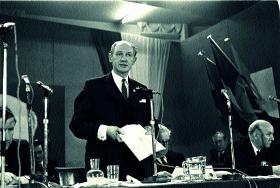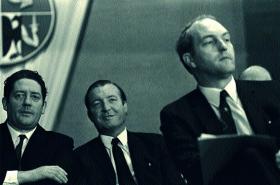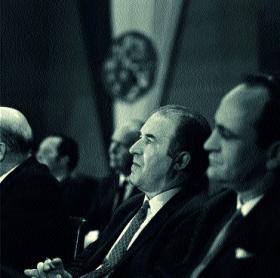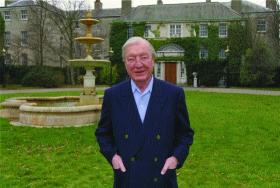TV Eye
Published in Issue 5 (Sep/Oct 2005), Reviews, Volume 13
Before the blood-letting of the Arms Trial—the Fianna Fáil Árd Fheis in January 1970. Within ten years of his disgrace in 1970 Charles Haughey had become taoiseach in succession to the man, Jack Lynch, who sacked him.
Haughey
RTÉ 1, June–July 2005
Directed by Niamh Sammon
Produced by Steve Carson and Miriam O’Callaghan
By Eamon O’Flaherty
The Haughey biography was one of the most controversial Irish television histories of recent years. One of the major participants, Desmond O’Malley, dissociated himself from the series as it was being broadcast, claiming that he had been misled about the purpose of the film, a claim vigorously denied by the producers. There was extensive media coverage, including an attack on the series by Vincent Browne in The Village and a defence of the series by the main commentator, Declan Kiberd, in the Irish Times. At one point it seemed as if everyone in Ireland was discussing the series, which is a tribute to the fascination Charles Haughey continues to exercise over the public mind thirteen years after leaving office.
At the heart of the controversy generated by the film is the sense that for many people, including a substantial section of the Fianna Fáil party, the Haughey legacy is still unresolved. Are we seeking an assessment of Haughey’s role in modern Irish history or a resolution of the questions arising from the endless stream of revelations about corruption that gathered pace from the middle of the 1990s? Or are we simply looking, in a very old-fashioned way, for the key to Haughey’s character? The series tried, with varying degrees of success, to address all of these questions.

Haughey is flanked by long-time rival George Colley and Brian Lenihan, who was sacked by Haughey as minister for defence amid great acrimony 20 years later.
As a piece of television, the four hour-long programmes were an impressive feat of editing. The producers managed to interview an enormous number of Haughey’s political contemporaries, especially those within the Fianna Fáil family. There were very significant contributions from some outsiders like Garret Fitzgerald or T.K. Whittaker, and some commentators, notably Declan Kiberd, but on the whole this was an assessment made by those who had been closest to Haughey in his long career in Fianna Fáil—crossing the entire spectrum from P.J. Meara to Desmond O’Malley. In many ways it gave a privileged insight into the nature of the political party that has dominated the state as it adjusted to the handover from the founding generation to the new cohort of leaders, which emerged in the 1960s.
Haughey was basically an outsider by background. Without any real connections in Fianna Fáil, his breakthrough after an unsuccessful period in the 1950s owed more to his driving ambition and real ability than to his marriage to the daughter of Seán Lemass. The first phase of Haughey’s career was abruptly terminated by his dismissal from cabinet and trial for conspiracy to import arms in 1970. In less than a decade he had revealed most aspects of the career that was to last for another 22 years. These included a close and profitable relationship with wealthy businessmen and property developers, an uncanny combination of populist gestures and patrician personal tastes, and an ability in government that far outshone his rivals.
Within ten years of his disgrace in 1970, Haughey had become leader of Fianna Fáil and taoiseach in succession to the man who had sacked him. It was clear from the film that many within Fianna Fáil never liked him or trusted him. One of the secrets of his success was an extraordinary ability to create a personal following around himself and to build a faction within the party that was the platform for his capture of the leadership.

Neil Blaney was also sacked by Lynch but, unlike Haughey, remained in the political wilderness. (© RTÉ Stills Library)
The loyalty of the non-Haughey faction to the party explained much about his tenacious hold on power despite the disastrous record of his first term in government—‘GUBU’ and economic chaos. When the party finally split in 1986–7, large numbers of the old guard chose to remain. It was hard to avoid wondering, when listening to Seamus Brennan or David Andrews, whether there were any limits to their loyalty to an organisation that was dominated by a leader whom they regarded as ruthless and politically corrupt.
It was the perfect irony that Haughey should have been the victim of the kind of factionalism that he had created when he in turn was brought down by a conspiracy against him orchestrated by Albert Reynolds and Pádraig Flynn, but triggered by the revelations of phone tapping made by Seán Doherty, whose career was destroyed to salvage Haughey’s reputation. The language of the principal actors gave an excellent insight into the viciousness of the power game at this level. Meara’s smoothly amoral handling of the process was complemented by Flynn’s extraordinary performance for the camera. Lit from below like a character from a horror movie, Flynn’s obvious relish for the murky recesses of power politics was the most fascinating revelation of all.
None of these details would have quite the impact they do now were it not for the exposure of Haughey’s personal corruption that emerged after he was forced out of office by Reynolds’s palace coup. Journalists like Browne had been pursuing the sources of Haughey’s personal wealth for years, but the accidental civil war in the Dunne family empire unleashed the tribunals of enquiry and the destruction of Haughey’s reputation. The angry reaction to the film in some quarters stems from frustration that Haughey has never been properly tried or punished for his transgressions, and also from the defence made by those who financed him that there was nothing wrong with paying him a secret subsidy. The revelations about the Ansbacher system—and indeed the banal reality of corruption and tax evasion in recent years—indicate just how far-reaching the consequences of corruption at the top could be. Most of the politicians interviewed tended to dwell on the personal aspects of Haughey’s corruption, as if the problem was confined to the leader rather than the tip of a very large iceberg. When these are set against a record of achievements that made him responsible for the peace process and the economic recovery after 1987—neither assertion seriously challenged in the film—corruption seems to take on a lesser significance.

Haughey on the front lawn of his James Gandon-designed mansion, Abbeville, Kinsealy, Co. Dublin, in March 1996. Journalists like Vincent Brown had been pursuing the sources of Haughey’s personal wealth for years. (© RTÉ Stills Library)
In presenting Haughey as a flawed great statesman the film flatters him and his party. Particularly annoying was the regular use of a background of Celia Bartoli singing tragic baroque opera as each new murky detail was revealed. As Kiberd said, Haughey presented himself in Shakespearian terms in his resignation speech, but, as Kiberd also remarked of the Lenihan affair, Haughey showed himself to be like the layers of an onion, which, as they are peeled away, reveal that there is nothing at the centre.
- Eamon O’Flaherty lectures in history at University College Dublin.
















